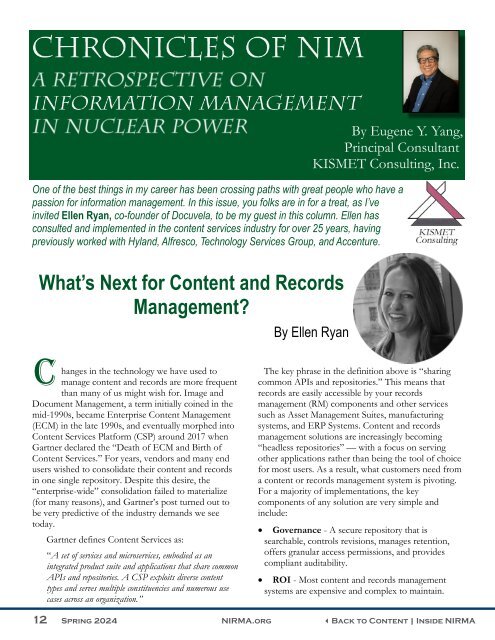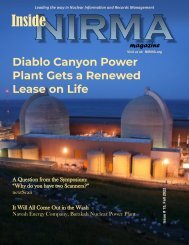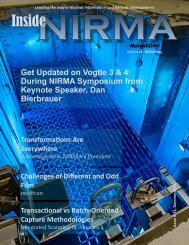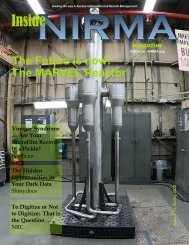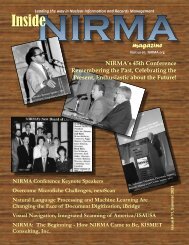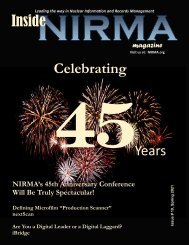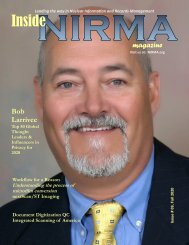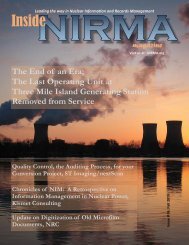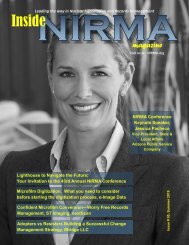Spring 2024 Inside NIRMA Magazine
Create successful ePaper yourself
Turn your PDF publications into a flip-book with our unique Google optimized e-Paper software.
By Eugene Y. Yang,<br />
Principal Consultant<br />
KISMET Consulting, Inc.<br />
One of the best things in my career has been crossing paths with great people who have a<br />
passion for information management. In this issue, you folks are in for a treat, as I’ve<br />
invited Ellen Ryan, co-founder of Docuvela, to be my guest in this column. Ellen has<br />
consulted and implemented in the content services industry for over 25 years, having<br />
previously worked with Hyland, Alfresco, Technology Services Group, and Accenture.<br />
What’s Next for Content and Records<br />
Management?<br />
By Ellen Ryan<br />
C<br />
hanges in the technology we have used to<br />
manage content and records are more frequent<br />
than many of us might wish for. Image and<br />
Document Management, a term initially coined in the<br />
mid-1990s, became Enterprise Content Management<br />
(ECM) in the late 1990s, and eventually morphed into<br />
Content Services Platform (CSP) around 2017 when<br />
Gartner declared the “Death of ECM and Birth of<br />
Content Services.” For years, vendors and many end<br />
users wished to consolidate their content and records<br />
in one single repository. Despite this desire, the<br />
“enterprise-wide” consolidation failed to materialize<br />
(for many reasons), and Gartner’s post turned out to<br />
be very predictive of the industry demands we see<br />
today.<br />
Gartner defines Content Services as:<br />
“A set of services and microservices, embodied as an<br />
integrated product suite and applications that share common<br />
APIs and repositories. A CSP exploits diverse content<br />
types and serves multiple constituencies and numerous use<br />
cases across an organization.”<br />
The key phrase in the definition above is “sharing<br />
common APIs and repositories.” This means that<br />
records are easily accessible by your records<br />
management (RM) components and other services<br />
such as Asset Management Suites, manufacturing<br />
systems, and ERP Systems. Content and records<br />
management solutions are increasingly becoming<br />
“headless repositories” — with a focus on serving<br />
other applications rather than being the tool of choice<br />
for most users. As a result, what customers need from<br />
a content or records management system is pivoting.<br />
For a majority of implementations, the key<br />
components of any solution are very simple and<br />
include:<br />
• Governance - A secure repository that is<br />
searchable, controls revisions, manages retention,<br />
offers granular access permissions, and provides<br />
compliant auditability.<br />
• ROI - Most content and records management<br />
systems are expensive and complex to maintain.<br />
12 <strong>Spring</strong> <strong>2024</strong> <strong>NIRMA</strong>.org Back to Content | <strong>Inside</strong> <strong>NIRMA</strong>


